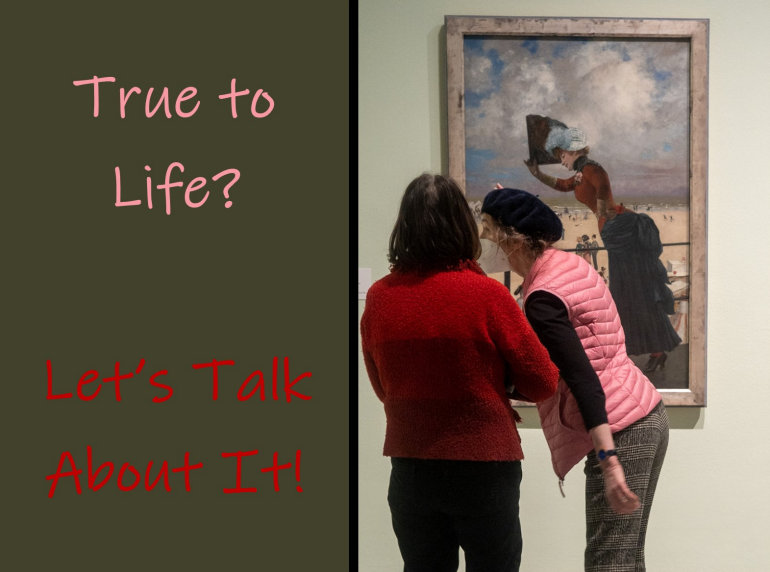ART: Social realism became an important thread in Victorian art, and one which required great skill from its practitioners. Much of it is dark, or sentimental, or intended for moral edification, so I offer the less gloomy comparison below to get us started! rb.



Some questions: Two later Victorian depictions of passengers in a London omnibus. Are both equally detailed? What is the nature of the detail in each case? Does either imply a narrative? Why has each artist chosen that particular selection of passengers? Do any of the faces look like portraits? What do you think is the purpose of each painting—or if you like, does either have a message? Are these images you could use in a Ken Burns-type documentary about Victorian London?
NOVELS ON FILM: We shall look at scenes from four Victorian novels, comparing film or television productions from different dates. There is no need for advance preparation, but if you wish to refresh your memory, the novels are: Jane Eyre (Charlotte Brontë), Hard Times (Charles Dickens) and North and South (Elizabeth Gaskell) compared with each other, and Far From the Madding Crowd (Thomas Hardy).
PEOPLE: Here are brief bios of the painters and novelists shown in the class.
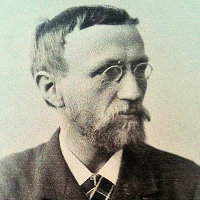 |
Hans Andersen Brendekilde, 1857–1942. Danish painter. Born Hans Andersen, a relative of the famous writer, he took the name of his village as a nom de plume. He was a social realist painter, tackling especially the condition of the working man. |
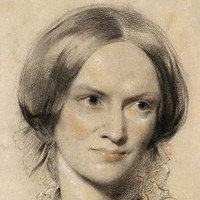 |
Charlotte Brontë, 1816–1855. English novelist and poet. Charlotte was the oldest and longest-lived of the three Brontë sisters (with Emily and Anne), all of whom were novelists. Her most famous book is Jane Eyre, published pseudonymously in 1847; her later Shirley (1849) was less successful. |
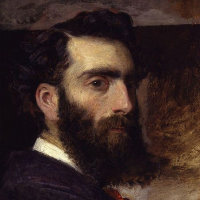 |
Philip Hermogenes Calderon, 1833–98. Franco-Spanish-English painter. Calderon was an English painter of French birth (mother) and Spanish (father) ancestry who initially worked in the Pre-Raphaelite style before moving towards historical genre. He was Keeper of the Royal Academy in London. [Wikipedia] |
 |
John Collier, 1850–1934. English painter. Collier was a highly successful portraitist and painter of scenes from life, often with a "puzzle picture" element. He was connected through both his marriages to the family of Thomas Huxley, President of the Royal Society. |
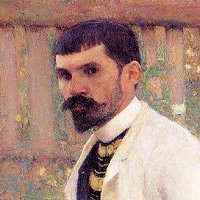 |
Pascal Dagnan-Bouveret, 1852–1929. French painter. After studying with Alexandre Cabanel and Jean-Léon Gérôme, he made his name as a naturalist painter, depicting scenes from his native Brittany, but also a variety of literary and religious subjects. His 1880 painting, An Accident, won the first-class medal at the Salon. |
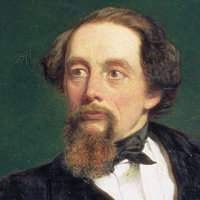 |
Charles Dickens, 1812–70. English Novelist. Dickens wrote 15 novels, several novellas, and numerous stories. Many of these were originally published in serial form, enabling him to build a large and eager readership, and to shape his work in response to public opinion. He also edited several magazines over the course of his life, and sponsored the work of other writers. A lifelong reformer, he increasingly devoted his time to political writing, lecture tours, and readings of his own work on both sides of the Atlantic. [The image is a detail of a portrait by Frith.] |
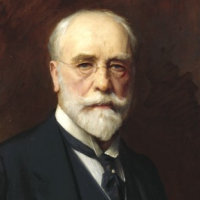 |
Luke Fildes, 1843–1927. English painter. Sir Luke Fildes was one of a number of mid-century English painters concerned with the condition of the poor. He began his career as an illustrator for the weekly periodical The Graphic, believing that art could be a powerful force for reform. He gradually shifted to pure painting, but continued realist subjects among others that were more purely pictorial. |
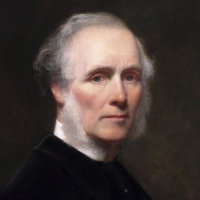 |
William Powell Frith, 1819–1909. English painter. Frith began his career as a portrait painter (his subjects including Charles Dickens), but branched out to literary and genre subjects and the vast panoramas of contemporary life such as Derby Day and Railway Station that became his best-known legacy. |
 |
Elizabeth Gaskell, 1810–65. English novelist. The daughter of a Unitarian minister who gave up his position in the North for reasons of conscience, Mary Stevenson married another minister, who moved to Manchester, which became the disguised setting for North and South (1855). She published this, its predecessor Cranford (1853), and a biography of Charlotte Brontë (1857) under the name "Mrs Gaskell," but used a pseudonym before that. |
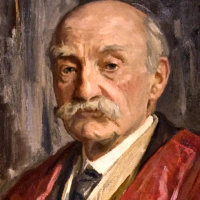 |
Thomas Hardy, 1840–1928. English novelist and poet. Although thinking of himself primarily as a poet, Hardy is most often remembered as the author of pastoral realist novels set in "Wessex," his name for a large swath of Southwest England, the country that he loved. While Far From the Madding Crowd ends happily, more of his novels have an elegaic pessimism that is found also in his verse. |
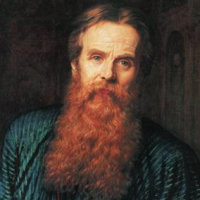 |
William Holman Hunt, 1827–1910. English painter. One of the founders of the Pre-Raphaelite Brotherhood, his paintings were noted for their vivid color, precise detail, religious or moral subjects, and profuse symbolism. His The Light of the World became one of the most reproduced paintings in the late 19th and early 20th centuries. |
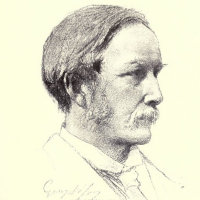 |
George William Joy, 1844–1925. Irish painter. Though born in Dublin, Joy lived and worked in London. He specialized in historical scenes, including contemporary history—his Death of General Gordon, 1885 (1893) is his best-known work—but also did portraits and scenes of everyday life, such as The Bayswater Omnibus (1895). |
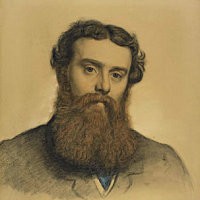 |
Robert Braithwaite Martineau, 1826–69. English painter. Martineau shared a studio with William Holman Hunt, who was in effect his teacher; the portrait of him here is by Hunt. He similarly painted realistic scenes with a moral purpose, such as The Last Day in the Old Home (1862). |
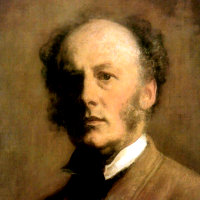 |
John Everett Millais, 1829–96. English painter. Millais was, with DG Rossetti and William Holman Hunt, one of the founders of the Pre-Raphaelite Brotherhood in 1848. At first noted for his highly realistic treatment of religious and literary subjects, he later adopted a more sentimental style, with which he was hugely successful. |
 |
Alfred Morgan, 1836–1924. English painter. Several of Morgan's works in mural and mosaic are in the Victoria and Albert Museum, but apart from his painting of Prime Minister Gladstone riding a London omnibus, One of the People (1885), I can find out little more about hism. |
 |
José Uría y Uría, 1861–1937. Spanish painter. Uría was born and worked mainly in Oviedo in Northern Spain, specializing in portraits and scenes from contemporary life. [The image is by him, but may not be of him.] |
ART: For the paintings discussed (or intended to be discussed) in class see below. Scroll to the end or click these links to reach the sections on NOVELS/FILM and BIOS.
COMPARISON 1



Some questions: Two later Victorian depictions of passengers in a London omnibus. Are both equally detailed? What is the nature of the detail in each case? Does either imply a narrative? Why has each artist chosen that particular selection of passengers? Do any of the faces look like portraits? What do you think is the purpose of each painting—or if you like, does either have a message? Are these images you could use in a Ken Burns-type documentary about Victorian London?
Some facts: The two paintings are One of the People by Alfred Morgan (1836–1924) and Bayswater Omnibus by George William Joy (1844–1925). Joy's appears to be a slice of life: a number of random passengers from a relatively affluent part of town. Its style, though realist, is closer to Impressionism. The man in the top hat in Morgan's picture is the Prime Minister, William Gladstone, hence the title; in this case, the realism serves a political or social end. Although you could make up stories about the various passengers in either picture, there seems to be no single overall narrative.
COMPARISON 2
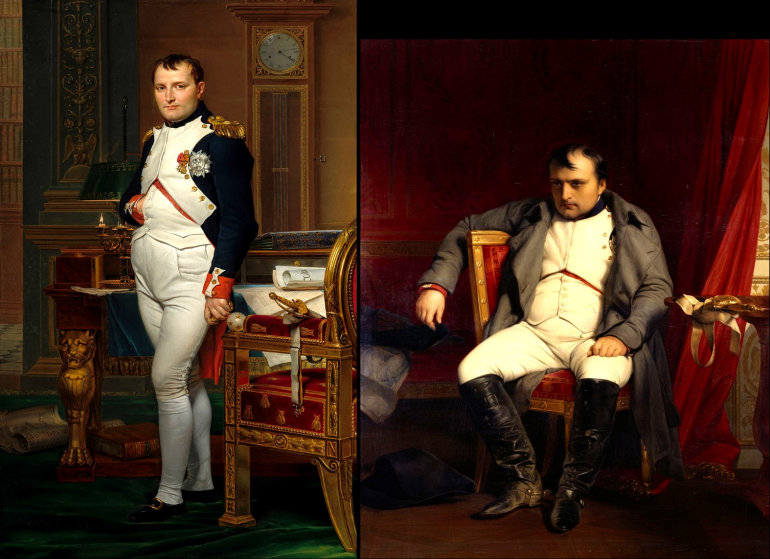


Some questions: Both of these are versions of the same picture; the smaller image above is the original, to give an idea of the color; click for details of the lower version. What is being represented? What might be the artist's intention? What stories can you imagine around various groups? Are all of these private stories of concern only to the people involved, or are some of them matters that might have been reported in the newspapers? Do any of the people look like portraits? And again, is this something that Ken Burns might use for a documentary?
Some facts: The artist is Sir William Powell Frith (1819–1909). Although called simply The Railway Station, the setting is Paddington, completed a decade earlier. The central group shows the artist and his family; the boy with with the cricket bat is presumably going off to boarding school. The bearded man in the fur coat was modeled by the family's Italian tutor, but here he seems part of a different story, arguing over his cab fare. At the extreme right, we see a man being arrested a moment before boarding the train; I read that this was a notorious case, but cannot find details. Frith was paid an enormous sum by a London dealer not to show this at the Academy, allowing the dealer to make a substantial profit by charging admission at a shilling a head!
COMPARISON 3



Some questions: What has happened? What will or may happen? And how do people feel about it? As an extra, what can you deduce about the social setting in each case?
Some facts: An Accident won Pascal Dagnan-Bouveret (1852–1929) his first big success at the Salon of 1880. Apparently he was traveling with a medical friend who was summoned to the house of a local family—though almost certainly the figures he painted here were posed later in the studio. There is no explicit narrative except the fact that the boy has injured his hand, but is likely to recover. The situation is much less clear-cut in The Doctor by Sir Luke Fildes (1843–1927), where the child is sick and may or may not survive. In fact Fildes has lost his own infant son shortly before painting this, although it was a commission by Henry Tate for his new gallery and not a spontaneous creation.
COMPARISON 4




Some questions: Just looking at these pictures without knowing anything more about them, how do they compare in terms of overall mood? What can you tell about the seated man with the young woman at his feet? What was his profession? What do the details in the picture tell us? In the picture with the six figures (actually seven), are there any details that seem out of place in a normal family scene? Mentally divide the characters into three pairs (left, center, and right); how do the attitudes of each pair differ from the others? What titles might you guess for each of the two paintings?
Some facts: The painting set in the baronial mansion is The Last Day in the Old Home by Robert Martineau (1826–69). If you could get close enough, you would see that the pamphlet on the floor at bottom right is a notice for an auction at Christies. It is clear that the family can no longer maintain their ancestral home and must sell up. The reason can be deduced from the horse painting on its side at left; perhaps the father is either a gambler or breeder who has thrown away his fortune; his easy-come-easy-go attitude would support this. The other painting is by John Everett Millais (1829–96); it is called The Northwest Passage and has the subtitle: "It might be done and England should do it." This refers to the search for a sea passage between Canada and the Arctic, something of a test of heroism for British explorers, at which many expeditions had already failed. There is an implication that the man might be a veteran of one of these expeditions.
COMPARISON 5



Some questions: What is going through the young woman's mind in each case? What is the pre-story? What has triggered her reaction? Does either woman have a ring on her finger? How do the other details in each picture combine to support its narrative? What titles would you give to each if you didn't know? Is either intended to convey a moral message?
Some facts: The pictures are The Awakening Conscience (1853) by William Holman Hunt (1827–1910) and Broken Vows (1856) by Philip Hermogenes Calderon (1833–98), both in the Tate. Both artists take us into the mind of the young woman in the foreground. In the Calderon, the situation is simple: the man behind the fence (perhaps her fiancé; she is wearing a very simple ring) is flirting with someone else. To understand the Hunt, however, we have to be able to parse the setting, and see it not as a family home but a rather garish love-nest that the man has furnished for his mistress. All the details, down to the music they are singing, suggest that she is on a slippery slope that can only end in ruin. But the ray of light on the floor in front and the reflection in the mirror of the garden beyond hint that there might yet be hope of redemption. There is a detailed analysis on Wikipedia.
COMPARISON 6



Some questions: What is the relationship between the standing figure and the crouching woman in each case? What is lying on the bed in the Collier? What is the box on the table in the Degas? Compared to other scenes from real life that we have seen, these look almost staged; might one or both have a literary source?
Some facts: Without noticing that the object on the bed in the painting by John Collier (1850–1934) is a wedding dress, or reading his title, Mariage de convenance, one might come up with a quite different interpretation. Even so, there are ambiguities: is the daughter to marry because the family needs the money, or because she is pregnant? Edgar Degas (1834–1917) also referred to his painting as The Rape, though that was not the name under which he exhibited it. The Wikipedia article gives a very detailed discussion of the various suggestions about its possible literary source, but none of them quite fits the artist's alternate title.

José Uría y Uría: After a Strike (1895, Oviedo)
Some questions: This picture seems to exist on two levels: how you see it before you know its subjects, and how you react once you do. If you didn't know the title, what elements in the picture might enable you to figure one out? And once you do know the subject, how does it engage your sympathies?
Some facts: José Uría y Uría (1861–1937) was a painter from northern Spain; I know very little more about him. Depictions of strikes were apparently not uncommon in the later 19th century; what is unusual about this one is how intimate and personal it is.

H. A. Brendekilde: The Highway (1893, Copenhagen)
Some questions: What is the occupation of the two men? What might the standing one be saying? What is going on in the background? Does the picture have any kind of message?
Some facts: Hans Andersen Brendekilde (1857–1942) was a Danish realist concentrating on social themes, many of which also have religious overtones. The fact that the man in this picture addressing the family of stone-breakers is identified as a carpenter, together with his gesture and general appearance, appears to present him as a modern Jesus. The funeral in the background is probably there for mood, or perhaps to show the indifference of the official church.
NOVELS ON FILM: Since one at least of the comparisons I showed in class was taken from videos I
had either bought or rented, I am unable to replicate any of them from things that are available on YouTube. However, the
older Far from the Madding Crowd film is available complete, as is Hard Times, albeit in four episodes. And
there are trailers of the others to remind you of their character.
Brontë: Jane Eyre: 1996 trailer
Brontë: Jane Eyre: 2011 trailer
Dickens: Hard Times: 1977, episodes:
[1]
[2]
[3]
[4]
Gaskell: North and South: 2004 trailer
Hardy: Far from the Madding Crowd: 1967 film complete
Hardy: Far from the Madding Crowd: 2015 trailer
The script for this part of the class can be found here.
PEOPLE: Here are brief bios of the painters and novelists we considered in the class.
 |
Hans Andersen Brendekilde, 1857–1942. Danish painter. Born Hans Andersen, a relative of the famous writer, he took the name of his village as a nom de plume. He was a social realist painter, tackling especially the condition of the working man. |
 |
Charlotte Brontë, 1816–1855. English novelist and poet. Charlotte was the oldest and longest-lived of the three Brontë sisters (with Emily and Anne), all of whom were novelists. Her most famous book is Jane Eyre, published pseudonymously in 1847; her later Shirley (1849) was less successful. |
 |
Philip Hermogenes Calderon, 1833–98. Franco-Spanish-English painter. Calderon was an English painter of French birth (mother) and Spanish (father) ancestry who initially worked in the Pre-Raphaelite style before moving towards historical genre. He was Keeper of the Royal Academy in London. [Wikipedia] |
 |
John Collier, 1850–1934. English painter. Collier was a highly successful portraitist and painter of scenes from life, often with a "puzzle picture" element. He was connected through both his marriages to the family of Thomas Huxley, President of the Royal Society. |
 |
Pascal Dagnan-Bouveret, 1852–1929. French painter. After studying with Alexandre Cabanel and Jean-Léon Gérôme, he made his name as a naturalist painter, depicting scenes from his native Brittany, but also a variety of literary and religious subjects. His 1880 painting, An Accident, won the first-class medal at the Salon. |
 |
Charles Dickens, 1812–70. English Novelist. Dickens wrote 15 novels, several novellas, and numerous stories. Many of these were originally published in serial form, enabling him to build a large and eager readership, and to shape his work in response to public opinion. He also edited several magazines over the course of his life, and sponsored the work of other writers. A lifelong reformer, he increasingly devoted his time to political writing, lecture tours, and readings of his own work on both sides of the Atlantic. [The image is a detail of a portrait by Frith.] |
 |
Luke Fildes, 1843–1927. English painter. Sir Luke Fildes was one of a number of mid-century English painters concerned with the condition of the poor. He began his career as an illustrator for the weekly periodical The Graphic, believing that art could be a powerful force for reform. He gradually shifted to pure painting, but continued realist subjects among others that were more purely pictorial. |
 |
William Powell Frith, 1819–1909. English painter. Frith began his career as a portrait painter (his subjects including Charles Dickens), but branched out to literary and genre subjects and the vast panoramas of contemporary life such as Derby Day and Railway Station that became his best-known legacy. |
 |
Elizabeth Gaskell, 1810–65. English novelist. The daughter of a Unitarian minister who gave up his position in the North for reasons of conscience, Mary Stevenson married another minister, who moved to Manchester, which became the disguised setting for North and South (1855). She published this, its predecessor Cranford (1853), and a biography of Charlotte Brontë (1857) under the name "Mrs Gaskell," but used a pseudonym before that. |
 |
Thomas Hardy, 1840–1928. English novelist and poet. Although thinking of himself primarily as a poet, Hardy is most often remembered as the author of pastoral realist novels set in "Wessex," his name for a large swath of Southwest England, the country that he loved. While Far From the Madding Crowd ends happily, more of his novels have an elegaic pessimism that is found also in his verse. |
 |
William Holman Hunt, 1827–1910. English painter. One of the founders of the Pre-Raphaelite Brotherhood, his paintings were noted for their vivid color, precise detail, religious or moral subjects, and profuse symbolism. His The Light of the World became one of the most reproduced paintings in the late 19th and early 20th centuries. |
 |
George William Joy, 1844–1925. Irish painter. Though born in Dublin, Joy lived and worked in London. He specialized in historical scenes, including contemporary history—his Death of General Gordon, 1885 (1893) is his best-known work—but also did portraits and scenes of everyday life, such as The Bayswater Omnibus (1895). |
 |
Robert Braithwaite Martineau, 1826–69. English painter. Martineau shared a studio with William Holman Hunt, who was in effect his teacher; the portrait of him here is by Hunt. He similarly painted realistic scenes with a moral purpose, such as The Last Day in the Old Home (1862). |
 |
John Everett Millais, 1829–96. English painter. Millais was, with DG Rossetti and William Holman Hunt, one of the founders of the Pre-Raphaelite Brotherhood in 1848. At first noted for his highly realistic treatment of religious and literary subjects, he later adopted a more sentimental style, with which he was hugely successful. |
 |
Alfred Morgan, 1836–1924. English painter. Several of Morgan's works in mural and mosaic are in the Victoria and Albert Museum, but apart from his painting of Prime Minister Gladstone riding a London omnibus, One of the People (1885), I can find out little more about hism. |
 |
José Uría y Uría, 1861–1937. Spanish painter. Uría was born and worked mainly in Oviedo in Northern Spain, specializing in portraits and scenes from contemporary life. [The image is by him, but may not be of him.] |
